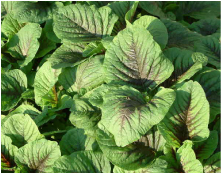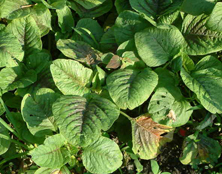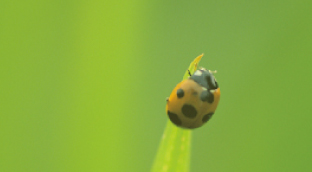|
 |
Effective Microorganisms and their Influence on Growth and Yield of Pigweed (Amaranthus dubians)
By Chrispaul Muthaura, David M. Musyimi, Joseph A. Ogur and Samuel V. Okello
Department of Botany and Horticulture, Faculty of Science, Maseno University, Maseno, Kenya (2010)
Pigweed (Amaranthus dubians) plants grow widely in many parts of the world. It is a very popular indigenous wild vegetable and is usually utilized by many communities as a nutritional additive. Pigweed is becoming very popular nowadays because of its high nutritive value and simple growth habits. However there is very little information about growth of this plant, using effective microorganisms, thus this study is designed to evaluate the effect of inoculation of effective microorganism on growth and yield of pigweed. The experiment was performed in five liter pots representing various conditions in the field. It comprised of four treatments, replicated, five times and arranged in a complete randomized design. One set of the treatments consisted of soil collected from the field, while the other treatments consisted of soil and organic manure prepared using effective microorganisms, sterilized soil treated with effective microorganisms, and sterilized soil plus organic manure without application of effective microorganisms respectively. Shoot height, stem diameter, leaf number per plant, leaf area, leaf fresh weight, leaf dry weight, root fresh weight, root dry weight and chlorophyll a and b contents were determined. Inoculated pigweeds with effective microorganisms recorded highest values in all the parameters measured except the root dry matter accumulation.There were significant differences (p>=0.05) in shoot height growth, stem diameter,leaf numbers per plant, leaf area, leaf fresh |
 |
| 使用益生菌 - 菜葉茂密、脆綠 |
|
 |
| 未使用益生菌 - 菜葉稀疏 |
|
and dry weight and root fresh and dry weights among treatments. There were no significant differences in leaf chlorophyll content among the treatments even though chlorophyll a and b contents were slightly higher in plants inoculated with effective microorganisms. The three other treatments had significantly lower values of the parameters determined. The results from this study demonstrated that growth and yield of pigweeds may be improved by inoculating the plants with effective microorganisms, and as a result reduce the use of fertilizers in production of this vegetable hence promoting sustainable agriculture. More studies would be needed to determine the effects of effective microorganisms’ inoculation on other amaranthus species.
The results from the study indicate that inoculation of pigweeds with effective microorganisms increased the growth of shoot height, stem diameter, leaf number, leaf area, leaf fresh and dry weights, and root fresh and dry weights. Increased shoot height stem diameter growth probably reflects allocation of resources into shoots rather than roots. Increase in the number of leaves and leaf area are common occurrences in plants that are provided with proper nutrition and this can increase the photosynthetic activity of the plants.
Increase in leaf area and number of leaves should result to higher rates of photosynthesis hence increased plant growth. For plants, a high rate of net carbon assimilation can result in higher biomass accumulation, favouring future growth and reproduction. The position and distribution of leaves along the shoot influences the sink strength of the plants. During early stages of leaf growth, synthesis of chlorophyll, proteins and structural compounds is high resulting in high catabolic rates to support energy needs by the plants. Inoculation of effective microorganism can increase the available nutrition for plant roots and improve photosynthesis. Singh et al. (2003) reported that biological seed and mucilage yield of Isabgol could be increased with application of animal manure and integrated systems due to improved soil physical and chemical properties. Accumulation of dry matter and its distribution into different plant components is an important consideration in achieving desirable economic yield from crop plants (Singh and Yadav, 1989). Chlorophyll a and b content increased in all the treatments, even though the plants inoculated with effective microorganisms had relatively higher chlorophyll contents.
In general effective microorganisms seem to have direct impact on growth and yield of pigweeds. Previous studies have demonstrated a consistent positive response with the use of effective microorganisms in crop production and indicate the potential of this technology to reduce fertilizer use and increase the yield and quality of crops (Higa, 1991)
The results show that inoculation of pigweeds (Amaranthus dubians) with effective microorganisms can improve their growth and yields. To prevent the environmental pollution from extensive application of fertilizers, the effective microorganisms could be recommended to farmers to insure the public health and a sustainable agriculture.The data collected proves that the use of effective microrganisms can lead to higher amaranthus yield (Amaranthus dubians). Further research should be done to quantify the numerous effects of EM on growth and yield of other amaranthus species. The local community should be sensitized on the use of EM to improve farming and thus help alleviate poverty; this should be done through workshops and seminars.
|
| |
 |
 |
|
|









